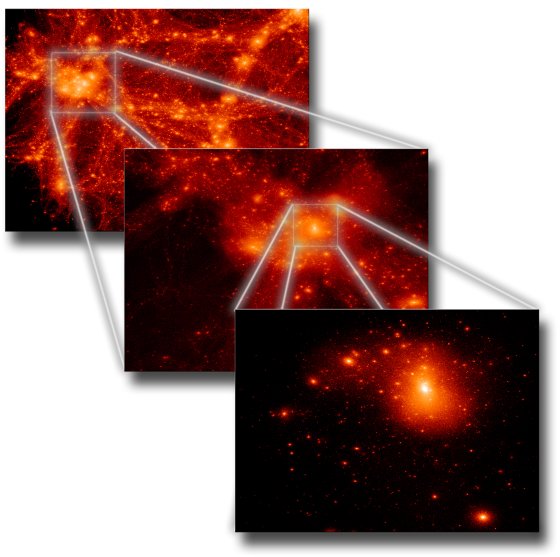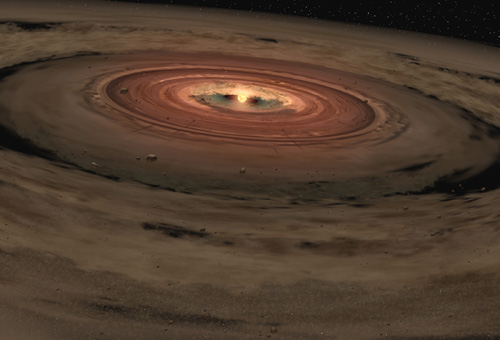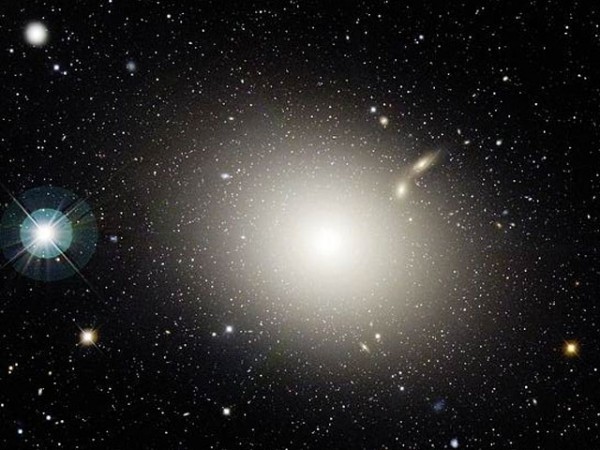It's only natural to wonder why things are the ways that they are. Take a look at our Solar System, for example.

A central bulge with planets, moons, and whatnot moving in a disc around it. Is this the way things have to be? My friend Rich, a chemist, asks:
It seems that all the objects in our solar system orbit the sun in nearly the same plane. Why is that? Why doesn't the solar system have spherical symmetry?
In particular, Rich wants to know why our Solar System doesn't look more like this:

Our Solar System is definitely not shaped like a sphere; it definitely is a bulge at the center with a disc on the outskirts. Well, I tried googling for bulge and disc and this was all I got.
But this shape, bulge + disc, is one of the most common in the Universe. In fact, we can look at scales much smaller than the Solar System, such as the gas giants, and what do we find?

A bulge at the center (the planet), with a disc -- rings and many moons -- orbiting it. Saturn's rings are the most spectacular, but Jupiter, Uranus and Neptune all have them, and they're all in the same plane as most of their massive moons.
But why look smaller than the Solar System? Why not look at galaxies too?

This famous "spiral" shape, when viewed edge-on, is clearly also just a bulge and a disc. So this shape that Rich is asking about is actually very, very common. How did we get stuck with this?
The bulge part is easy: gravity. All of us -- planets, solar systems, and galaxies -- form from gravitational collapse. You take a big blob of mass, you let gravity do its thing, and it collapses down as best it can. But these initial blobs are never perfect spheres. The stuff that forms galaxies looks like this.

While the stuff that forms stars looks like this.

In other words, the initial shape is not a perfect sphere. You have three dimensions to play with, and it's always shortest in one dimension and longest in another. We have a fancy name for shapes like this -- a triaxial ellipsoid -- but it's just a sphere that's stretched and crunched like so.

In the diagram above, the blue direction is the shortest. Newton's gravity is good enough to tell us that the shortest direction collapses the fastest, while the largest directions take longer to collapse down. But the galaxy, the solar system, and even the region where planets form are full of normal matter. What happens when you run two blobs of matter (or two halves of one blob of matter) into each other at high speeds?

Well, yes, they go "SPLAT!" But more importantly, they form a pancake-like shape. Now, if gravity were the only thing going on, all of this splatter along the other two axes (the ones that didn't collapse first) would eventually be pulled in towards the center, which means we'd just get a bulge.
But there's one more piece to the puzzle: things rotate. (In physics, we call this conservation of angular momentum.) Galaxies, star systems, and individual planets all rotate, because they all start with some rotational energy, and that remains. The stuff that doesn't have enough rotational energy collapses inwards, and becomes part of the bulge. But the stuff that is rotating quickly enough stays on the outskirts, and forms the disc.

So everything -- planets, solar systems, and galaxies -- all form, initially, with this "bulge + disc" shape. No giant atoms.
"But wait a minute," you might say. "What about elliptical galaxies? Aren't they exactly what Rich is asking about?"
Ahh, ellipticals. Galaxies that look, well, like giant Bohr atoms.

They didn't form this way! The way you make an elliptical galaxy is by taking two or more "normal" (i.e., spiral) galaxies and smacking them into each other. The stuff that results from this collision is elliptically shaped, as you can see for yourself.
We haven't seen one yet, nor do we know if they'd be stable, but that's what it would take. And now you know.
- Log in to post comments





But what if the Oort cloud really exists? Wouldn't that technically still be gravitationally bound to our sun and thus make the tender outer shell of our solar system spherical?
Galaxy collision simulation is well done.
Would be great to see the time frame of it.
Questions:
- Is a expansion of space somehow observable?
- Would it have an influence on the galaxy collisions?
- Are we in an expanding space bulb?
KRGDS and TKS
Would this explain why the orbits of the planets aren't circular?
No, ShadowWalkyr; that's a question of Kepler's Laws.
All the planets presumably had circular orbits and were coplanar as they accreted matter. After being formed, gravitational resonances over time perturbed the orbits and some of them became more elliptical than others, and the planes of some orbits changed.
When you look at the satellites of gas giants, you find that the ones that are further in have circular orbits which are usually but not always (Triton is the exception) in the equatorial plane of the planet. The ones further out are more likely to have elliptical orbits which are inclined to the equatorial plane.
When you are in an elliptical orbit around a planet with a substantial atmosphere, that atmosphere produces a drag which slows you down. Generally the density, and therefore the drag, is higher as you get closer to the planet. Since your speed at periapsis is therefore lower with each orbit (ceteris paribus), your apoapsis is lower with each orbit, until they eventually become equal and you have a circular orbit. (The radius of this orbit also tends to decrease with time, eventually pulling the satellite too close to the planet to stay in one piece.) This process takes a few decades for artificial satellites in low Earth orbit and somewhat longer as you go further out and/or have more mass. There hasn't been enough time for this process to act on the Moon, the planets orbiting the Sun, or the outer satellites of the gas giants (the fact that many objects in the last category were captured well after the solar system formed doesn't help).
I'm not so sure why the inner satellite orbits tend to converge on the satellite's equatorial plane, other than the tendency Evan pointed out in the original post for satellites to form in that plane to begin with. But I have trouble explaining, without there being some such forcing, why the inner satellites of Uranus orbit in the equatorial plane of Uranus, which is itself tilted 98 degrees with respect to the orbital plane of Uranus about the Sun. The equatorial bulge would have to be a factor here.
Robert's explanation @5 for why planets are in different orbital planes is definitely wrong. To change the orientation of an object's orbital plane requires a torque (because you are changing the angular momentum vector), and producing that torque requires a force with a component out of the plane. Thus this torque cannot be generated by anything orbiting in the same plane. You can, however, change the magnitude of the angular momentum in this way, which is how you can sweep out certain orbits.
Robert's explanation @5 is definitely NOT wrong. :p :)
His reference is "Origin of the orbital architecture of the giant planets of the Solar System" by Tsiganis et al. in Nature, Vol 435/26 May 2005, p 459-461.
Robert offers this quote from the article:
"The secular perturbations that Jupiter and Saturn exert on Uranus and Neptune force the eccentricities of the ice giants to increase by an amount that depends on the masses and semimajor axes of all planets. As a result of the 'compactness' of the system, the planetary orbits become chaotic and intersect. When this occurs, a short phase of encounters follows the resonance crossing event. These encounters increase the inclinations of the planetary orbits by 1°â7°. In addition, both ice giants are scattered outward and penetrate the disk. Thus, the flux of small bodies towards Saturn and Jupiter, and hence their rate of migration, increases abruptly. During this fast migration phase, the eccentricities and inclinations of the planets slowly decrease by dynamical friction and the planetary system is stabilized. The planets stop migrating when the disk is almost completely depleted."
Does the geodetic effect come into play at all? I've not really investigated frame-dragging phenomena.
Here is a paper that proposes a possible explanation for how resonating frequencies might have determined the terrestrial planets' inclinations based on what they call the "jumping Jupiter" model:
http://arxiv.org/pdf/0909.1891
To the writer of this article - I read your post from a few months ago about the LHC. I'm really terrified by this experiment. I guess what your said in your post makes sense, but what do you say about recent researchers that found some major concerns for the LHC safety? They basically say that these black holes have the potential to last a few minutes! I would really like to relax. All of these doomsday scenarios really scare me.
There are much higher-energy collisions than the LHC can accomplish happening in the atmosphere constantly. The LHC isn't doing anything unnatural; it's just doing some collisions in a controlled environment so the results can be measured better.
Then I suggest you don't read Phil Plait's Death from the Skies, which describes in great detail much more probable (though still quite improbable) doomsday scenarios.
I've read the safety report that explains that these things happen in nature, but the difference is that the LHC is trying to find the "god particle" which can potentially harm earth! I'm talking about recent articles like these -
http://science.slashdot.org/article.pl?sid=09%2F01%2F28%2F2247228&from=…
http://science.slashdot.org/article.pl?sid=09/01/23/145256
Not everyone agrees about the results of this thing.
I'm having lots of panic attacks because of these subjects.
I might have missed something but if I got it right, this structure is due to the initial shape of what formed it. If so you doesn't really answer the question since we don't know how come the initial structure is a triaxial ellipsoid. Here I mean I can't figure out how come there is a priviled direction.
Megan, do you happen to live anywhere close to Yellowstone in the USA (that is, within a 500 mile radius or so)? Then there's a non-zero probability that you will die in the caldera explosion which *will* happen sometime in the next hundred thousand years. (Probably more like a thousand, but it's hard to say.)
Do you live on either North American coast? Then you have a non-zero probability of dying in a tsunami generated by one of two islands collapsing and falling into the ocean. (One of these is the 'Big Island' of Hawaii, whose top third is rifting off very quickly in geological time; the other is a West-facing chunk of an island in the Canaries.)
It's actually more likely that all three of these events happen on the same day than anything bad happens from the LHC. There is no god to get pissed off at us finding the 'God particle'--so any fears you have on that account are better placed toward real issues in your life.
If you spent all your time panicking over everything that could possibly kill you (or kill everyone you've ever known, for that matter), you wouldn't be able to get out of bed. Your life is far too short to spend worrying about the LHC (or anything else I mentioned--and the near-uncountable things I failed to mention--which would have similar catastrophic effects on much of the population, if not the whole planet).